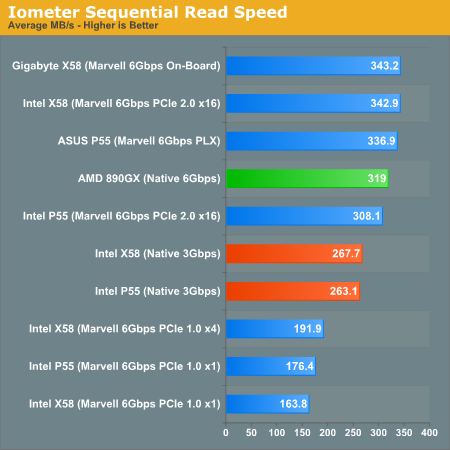6Gbps SATA Performance: AMD 890GX vs. Intel X58/P55
by Anand Lal Shimpi on March 25, 2010 12:00 AM EST- Posted in
- Storage
The First Test: Sequential Read Speed
The C300 can break 300MB/s in sequential read performance so it’s the perfect test for 6Gbps SATA bandwidth.

Intel’s X58 is actually the best platform here, delivering over 340MB/s from the C300 itself. If anything, we’re bound by the Marvell controller or the C300 itself in this case. AMD’s 890GX follows next at 319MB/s. It’s faster than 3Gbps SATA for sure, but just not quite as fast as the Marvell controller on an Intel X58.
The most surprising is that using the Marvell controller on Intel’s P55 platform, even in a PCIe 2.0 x16 slot, only delivers 308MB/s of read bandwidth. The PCIe controller is on the CPU die and should theoretically be lower latency than anything the X58 can muster, but for whatever reason it actually delivers lower bandwidth than the off-die X58 PCIe controller. This is true regardless of whether we use Lynnfield or Clarkdale in the motherboard, or if we’re using a P55, H55 or H57 motherboard. All platform/CPU combinations result in performance right around 310MB/s - a good 30MB/s slower than the X58. Remember that this is Intel’s first on-die PCIe implementation. It’s possible that performance is lower in order to first ensure compatibility. We may see better performance out of Sandy Bridge in 2011.
Using any of the PCIe 1.0 slots delivers absolutely horrid performance. Thanks to encoding and bus overhead, the most we can get out of PCIe 1.0 slot is ~192MB/s with our setup. Intel’s X58 board has a PCIe 1.0 x4 that appears to give us better performance than any other 1.0 slot for some reason despite us only using 1 lane on it.
Using one of the x1 slots on a P55 motherboard limits us to a disappointing 163.8MB/s. In other words, there’s no benefit to even having a 6Gbps drive here. ASUS PLX implementation however fixes that right up - at 336.9MB/s it’s within earshot of Intel’s X58.
It’s also worth noting that you’re better off using your 6Gbps SSD on one of the native 3Gbps SATA ports rather than use a 6Gbps card in a PCIe 1.0 slot. Intel’s native SATA ports read at ~265MB/s - better than the Marvell controller on any PCIe 1.0 slot.










57 Comments
View All Comments
sparkuss - Thursday, March 25, 2010 - link
Anand,I was going to maybe get two C300's for my current build. Do we consumers need to wait for your update before we invest in these?
We know it died, but I haven't been able to find any other reliability statistics collated anywhere to make a buying decision on.
sparkuss - Thursday, March 25, 2010 - link
Sorry, I missed the Update link in the upper corner.vol7ron - Thursday, March 25, 2010 - link
Great review. Not much to be said. There was a little bit of puffery at the end, in AMDs favor.I'm sure most companies have faster controllers/BIOSs to be released. Rather than saying AMD is something to look out for, for some reason I'd think Intel would have something greater.
As you mentioned, the on-die controller should have lower latencies - could you ask them about this? Perhaps some of the PCI bandwidth is being chewed up by something else, or perhaps the latencies are too low, causing a check/repeat bottleneck? (or maybe this a marketing ploy to release something faster in the future)
Dzban - Thursday, March 25, 2010 - link
Because AMD has native 6Gbps and they are improving drivers. With intel chipsets you can't phisicly increase speed further.vol7ron - Thursday, March 25, 2010 - link
I don't like how Intel switches between [Mb/s & Gb/s] and [MB/s & GB/s]. It'd be nicer to not have to translate 480Mbps into 60MB.I guess the issue was at first past I almost equated the 480Mb/s to the 500MB/s right under it.
jejeahdh - Thursday, March 25, 2010 - link
You should not type dates in that format, and if you had an editor, he or she should absolutely stop you from doing such things. People have expectations. You might think it's no worse than the ever-present traditional ambiguous formats of the US and Europe (m/d/yy(yy), d/m/yy(yy)) which are bad enough, but at least it's an old and well recognized problem that people are used to living with, so long as it uses slashes. People with knowledge of standards, though, use dashes for ISO date format, yyyy-mm-dd which is also perfectly sortable. By mixing and matching styles haphazardly, you're only propagating the notion that anything goes, causing people to stop and wonder for 12 days out of every month. If you're deliberately adopting the style commonly used in the Netherlands (I had to look it up) and advocating its use for an international audience, I cannot imagine why.I know it seems crazy to harp on this and I kind of agree . . . but I am just so surprised to see it here, written by a detail oriented technically minded accomplished writer.
strikeback03 - Friday, March 26, 2010 - link
If this is in response to the IOMeter build, that might be the way it was named by its creator, not Anand. Also, I would imagine 6-22-2008 is m-dd-yyyyassassin37 - Thursday, March 25, 2010 - link
Hey Anand, Why isn't the X-58 gigabyte native 6gbs board on the write benchmarks?assassin37 - Thursday, March 25, 2010 - link
never mind I read why, legacy modevailr - Thursday, March 25, 2010 - link
Intel releases SSD friendly AHCI/RAID driver:http://www.pcper.com/#NewsID-8538">http://www.pcper.com/#NewsID-8538